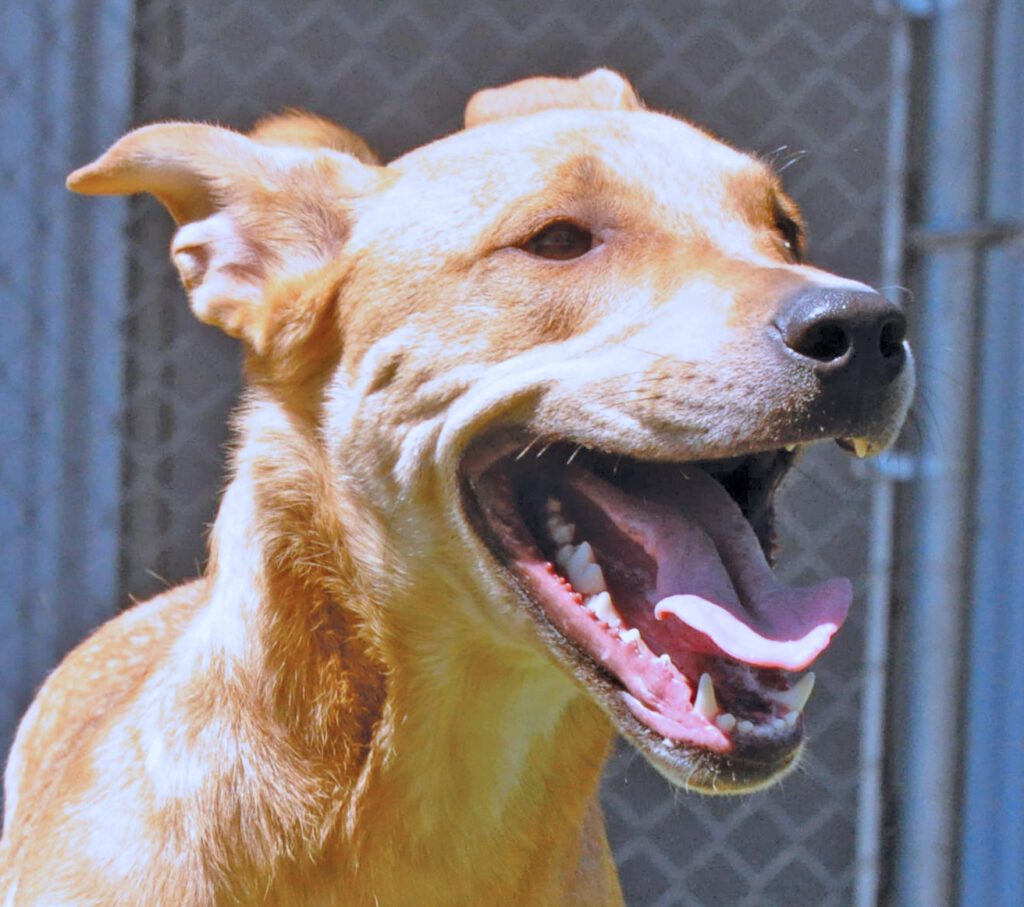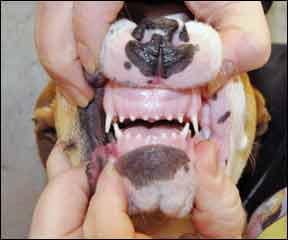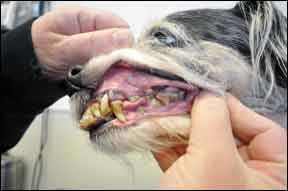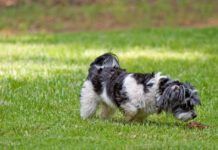
It’s funny: We share our homes with another species of animal, whose most dangerous feature is its teeth – and most of us know little or nothing about those teeth, other than the fact that we should probably be brushing them. It’s time to correct this situation.
First, some canine dental basics. Most animals (including humans) have teeth that reflect the diet they subsisted on as they evolved. Though we humans have a few mildly sharp teeth in the front of our mouths that we can use for tearing, most of our teeth are built for grinding plant-based foods so that we can better digest them. Conversely, most of the teeth in a dog’s mouth are built for tearing animal-based foods, with just a few teeth that crush their food before they swallow it.
Dogs’ teeth are not as sharp as cats’ teeth, but their teeth and jaws are much stronger. Their dental anatomy enables them to grab and kill prey animals that may be much larger than themselves, tear through thick hides, slice and pull flesh from bones, crack open small bones in order to consume the marrow inside, and gnaw on bigger bones to strip away and consume every bit of meat and connective tissue.
Most adult dogs have 42 teeth, though our genetic manipulation of the species has resulted in dogs with fewer or more. Reportedly, the gene that is responsible for hairlessness in the hairless breeds, such as the Chinese Crested, also modifies dentition, often leaving these breeds with fewer teeth. Doberman Pinschers often are missing molars.
Most adult dogs have six incisors (front teeth) on the top jaw and six on the bottom; two canine teeth (the largest “fangs”) on the top and two on the bottom; eight premolars on the top and eight on the bottom; and two molars on the top and three molars on the bottom.
The dog uses his front teeth – the smallest and most fragile teeth – for his most delicate operations. He uses these teeth to groom himself, pulling burrs and insects from his skin and coat. He also uses them when scraping edible tissue from the surface of bones. (This is likely the evolutionary basis for the behavior that many dogs engage in when they strip the “fuzz” off of tennis balls. Some dogs do this so persistently that they wear down the incisors if not prevented from access to tennis balls.)
While the term “canine teeth” is admittedly somewhat confusing (aren’t all the teeth in a dog’s mouth canine teeth?) the appellation is somewhat understandable when you realize that the dog’s “fangs” are the most distinguishing feature of his species. Whether it’s a Chihuahua or Great Dane, a dog’s canines are the ones that look most impressive when bared, and leave the deepest holes in a person they’ve bitten.
Few of us look far enough back in our dogs’ mouths to appreciate this, but dogs’ premolars and molars are far pointier than human molars. Many of us imagine that dogs are chewing and grinding their kibble much as we chew cereal, but in fact, dog premolars and molars can’t actually grind. Grinding requires an animal’s jaws to move sideways; think about how a cow or llama grinds its food, with extreme sideways jaw action. Dog jaws can’t move sideways! Instead, the dog’s strong jaws and large peaks on the premolars and molars are used to crush large chunks into smaller ones. Not much more physical processing of their food occurs in the dog’s mouth.
As much as dogs can be said to chew, most of the chewing action is provided by the premolars. The molars, located at the far back of the mouth – where the dog has the most jaw strength, like the base of a pair of pliers – are mostly used for extreme crunching.
Puppy Tooth Eruption
We can use the timing of the eruption of puppy teeth and adult teeth to help us estimate the age of a young dog, but after he’s about eight months old and has all his adult teeth, we have to use other clues to estimate his age, such as the amount of staining, wear, and accumulation of tartar on his teeth.

Puppies are born without teeth. The “deciduous” or “puppy” teeth start emerging when pups are about 4 weeks old. First to arrive are the front teeth (incisors, six on top and six on bottom), which emerge when the pup is 4 to 6 weeks old; the canines (two on top and two on bottom) erupt when the pup is about 5 to 6 weeks old; and the premolars (six on top and six on bottom) erupt at about 6 weeks. There are no deciduous molars.
The deciduous teeth are incredibly sharp. It has been speculated that the sharpness of puppy teeth serves to further two important developmental processes: weaning and bite inhibition. Too-vigorous biting, during nursing or play, causes an abrupt end to the previously gratifying activity, teaching the pup, through trial and grievous error, to restrict the severity of his bite. (For more about the development of bite inhibition, see “A Light Bite: Teaching Bite Inhibition,” WDJ June 2010.)
Soon enough (although perhaps not soon enough for most puppy owners), the pin-sharp puppy teeth begin to fall out – or, rather, are pushed out by the eruption of the adult teeth. The puppy teeth are generally lost in the order in which they arrived; and the adult teeth erupt in the same order: first the incisors, then the canines, and then the premolars. There is more variation in the timing of the eruption of the adult teeth, a wider window through which they may first be glimpsed. The adult incisors generally erupt between 3 to 5 months; the canines usually appear between 4 to 6 months; and the premolars between 4 to 5 months. The molars emerge between 5 and 7 months.
Sometimes a single tooth or a few deciduous teeth fail to shed even as the adult teeth erupt, resulting in a crowded-looking mouth. When this happens, it’s best to have your veterinarian extract the unshed puppy teeth, to prevent them from allowing the adult teeth to develop in an improper position.
This entire process of tooth eruption, loss, and eruption, lasting for many months, keeps the puppy’s mouth in constant torment, and he has to chew on things to relieve the sensation – hard things, soft things, chewy things, gummy things, crunchy things, anything, and everything! Knowing this, the wise puppy owner makes certain that the pup has lots of “legal” chew toys, and toys in every category (hard, soft, gummy, chewy, crunchy, and everything in between). If you fail to be thorough in providing chew toys of all textures, he’ll be sure to explore anything that you don’t want him to have that provides that missing, novel chewing experience.
Brushing Your Dog’s Teeth: Yes, You Need To
Here’s what most dog owners really want to know about their dogs’ teeth: “Do I really have to brush them?”
Although veterinary dental specialists would prefer that all owners brush their dogs’ teeth, the fact is that some dogs need it more than others. Whether it’s due to their genes, diet, chewing habits, and/or the chemical composition of their saliva, some dogs go to their graves with clean, white teeth and healthy gums with absolutely no effort put forth by their owners. Others develop tartar (also known as calculus) at an alarming rate.
The accumulation of plaque (a “biofilm” on the teeth that contains bacteria) and tartar (a mineralized concretion of plaque) is not just unsightly, it’s unhealthy. Tartar buildup at and under the gum line enables the entrance and growth of bacteria under the gums. Most dogs who have bad breath also have gingivitis – swollen and inflamed gums, usually bright red or purple, and which bleed easily. Unchecked, these bacterial infections in the gums slowly destroy the ligament and bony structures that support the teeth (periodontitis). Because of the ample blood supply to the gums, infections in the mouth can also poison the dog systemically, potentially causing disease of the heart, kidneys, and/or liver.
If your dog’s teeth are free of plaque or tartar, and his gums are tight and free of any signs of inflammation, you are one of the lucky ones. If, however, his gums are noticeably more red at the gum line and he has any visible tartar buildup on his teeth, you need to have his teeth cleaned by a veterinarian and then maintain the health of his teeth and gums with regular brushing and veterinary cleaning.

If you are one of the unlucky ones, and your dog’s teeth and gums need your intervention to stay healthy, how often do you really need to brush your dog’s teeth? Put it this way: the more you brush, the less frequently you’ll need to pay for a veterinary cleaning. Whether you would prefer to invest your time in patiently training your dog to enjoy having his teeth brushed or would prefer to invest in your veterinarian’s time is up to you!
A Few Dog Tooth Brushing Tips:
– Start out slow, and be patient. Don’t try to brush all of your dog’s teeth on the first day. Use a circular motion, gently scrubbing plaque away from the gum line. Reward your dog frequently and richly with treats and praise.
– The “brushes” that you wear on your fingertips don’t tend to work as well as brushes with softer bristles – and they make it much easier for your dog to accidently bite down on your finger. Look for very soft-bristled brushes with long handles, so you can make sure you reach the molars. For larger dogs, soft brushes meant for adult humans work fine; baby human toothbrushes work well for smaller dogs.
– If your dog will tolerate it (or you can positively and patiently teach him to accept it), electric toothbrushes work great! For some dogs, however, these whirring, vibrating brushes are a deal-breaker, no matter what kind of treats you offer.
– Use a toothpaste designed for dogs. They come in flavors that are meant to appeal to dogs (meaty, not minty) – and they are free of fluoride, which can be toxic to dogs. (Remember, dogs don’t know to spit the toothpaste out!) Look for products that contain antibacterial enzymes, which help discourage bacterial growth and resulting gingivitis.
– Dip the brush in water frequently as you brush, to help rinse the plaque away from your dog’s teeth, and to facilitate a thorough application of the antibacterial enzymes in the toothpaste.
Get to a Veterinarian
It can be painfully expensive, but the value of having your dog’s calculus-encrusted teeth cleaned at your veterinarian’s office is incalculable! The only way all of his teeth (even the molars) can be scrubbed completely of the tartar, above and below the gums, is under general anesthesia. This must be done at a veterinary clinic.
Whether due to the cost or the perceived risk of anesthesia, people want so much to believe that there is another way to get the dog’s teeth clean. Once a dog has a lot of tartar on his teeth, though, the only effective treatment is a professional cleaning under anesthesia. Once his teeth are clean, you can prevent the need for further veterinary cleaning only through scrupulous home care (brushing) – but you just can’t brush a tartar-encrusted mouth back to health. For one thing, you can’t (and shouldn’t try) to brush under the dog’s gums; this area is cleaned at the vet’s office with sterile instruments and with the use of a fine mist of water, which washes the bacteria out of the dog’s mouth. The ultrasonic (vibrating) tools available to the technician are also much faster and more accurate than any tool you would have access to.
What about “anesthesia-free” cleaning? Witnessing a veterinary cleaning, with the dog under anesthesia, is pretty much all you need to realize that no one is capable of doing what needs to be done to get a fully conscious dog’s teeth really clean. The most cooperative dog in the world just isn’t going to lie down on a table under necessarily super bright lights (so the technician can thoroughly examine the teeth for any signs of chips or painful fractures) and allow a vibrating, misting tool to be employed on his molars.
Further, in most states, it’s illegal for anyone to use a scaler on an animal’s teeth except under the supervision of a veterinarian. While there are many technicians and groomers who may be capable of removing some dental calculus from your dog’s teeth, only a veterinarian is qualified and equipped to recognize, diagnose, and treat any related (or unrelated) conditions the dog may have, such as fractured teeth or oral cancer. If his periodontal disease is advanced, x-rays will be needed to evaluate the supporting structures of the teeth.
Of course, in order to safely anesthetize your dog, your veterinarian will likely require a blood test in advance of the cleaning appointment, to evaluate your dog’s kidney and liver function. If his function is reduced, extra precautions and perhaps a different anesthetic protocol can be used.
Depending on your dog’s age and condition, your veterinarian may also administer intravenous fluids to your dog during the procedure, which can help regulate the dog’s blood pressure. The presence of an IV catheter and proper hydration levels also make it possible for a veterinarian to immediately administer life-saving medications in case of an adverse reaction to the anesthesia. In an emergency, the use of calcium, epinephrine, and/or atropine needs to occur as quickly as possible; having an IV in place makes this possible.
Finally, veterinarians can prescribe and dispense antibiotics to help your dog fight off any bacteria that was dislodged by the cleaning and absorbed into his bloodstream, as well as provide any sort of consultation or aftercare needed. The price tag of all of this can be large – and it can vary a lot from vet to vet, ranging from $400 to $1,400 (or even more if the dog requires tooth extractions).
After all this, you’ll probably be motivated to give that toothbrushing a try. Do it now, while you’re good and motivated; it could add years to your dog’s life.





